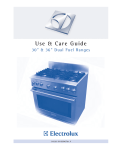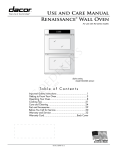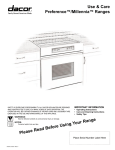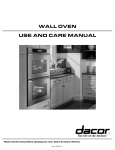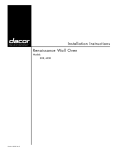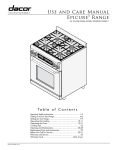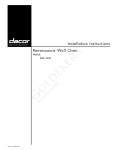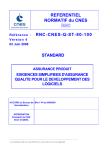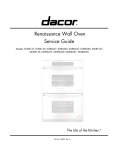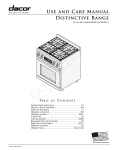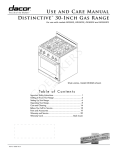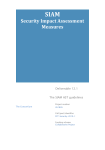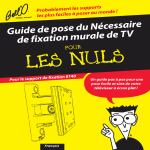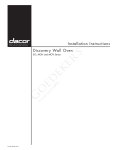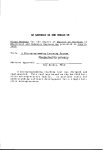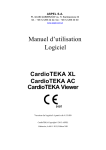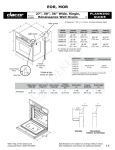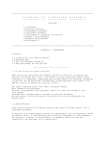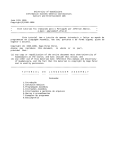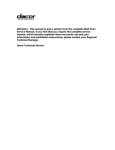Download Sears Oven EORD230 User's Manual
Transcript
Use and Care Manual Renaissance Wall Oven For use with models: EOR, MOR Style varies Model EORD230 shown Ta b l e o f C o n t e n t s Important Safety Instructions............................................1 Getting to Know Your Oven.............................................3 Operating Your Oven.....................................................8 Cooking Tips...............................................................21 Care and Cleaning......................................................23 Part and Accessories....................................................28 Before You Call for Service............................................29 Warranty and Service..................................................31 Notes.........................................................................32 Warranty Card................................................Back Cover Part No. 102580 Rev. P © 2007 Dacor, all rights reserved. Important Safety Instructions Installer: Leave these instructions with the appliance. Important Information About Safety Instructions Customer: Read this use and care manual completely before using this appliance. Save it for future reference. It contains important use and care information. Keep your sales receipt or canceled check in a safe place. Proof of original purchase date is required for warranty service. The Important Safety Instructions and warnings in this manual cannot cover all possible problems and conditions that can occur. Use common sense and caution when installing, maintaining or operating this appliance. For service and warranty information see page 31. Always contact the Dacor Customer Service Team about problems or conditions that you don’t understand. If you have any questions, other than warranty questions, call: Safety Symbols and Labels Dacor Customer Service (800) 793-0093 (U.S.A. and Canada) Monday — Friday 6:00 a.m. to 5:00 p.m. Pacific Time danger Web site: www.Dacor.com Immediate hazards that WILL result in severe personal injury or death. Have the complete model and serial number for your appliance available. The numbers are found on the appliance data plate, located inside the grill, below the control panel. Open the door to expose the grill. On double ovens, the plate is located behind the top grill. Write these numbers below for future reference. warning Hazards or unsafe actions that COULD result in severe personal injury or death. Model number __________________________________ caution Serial number __________________________________ Hazards or unsafe actions that COULD result in minor personal injury or property damage. Date of purchase ________________________________ View data plate through grate danger IMPORTANT: To avoid the possibility of explosion or fire, do not store or use combustible, flammable or explosive vapors and liquids (such as gasoline) inside or in the vicinity of this or any other appliance. Keep items that could explode, such as aerosol cans away from the burners and oven. Do not store flammable or explosive materials in adjacent cabinets or areas. warning WARNING - NEVER use this appliance as a space heater to heat or warm the room. Doing so may result in carbon monoxide poisoning and overheating of the appliance. warning WARNING - NEVER cover any slots, holes or passages in the oven bottom or cover an entire rack with materials such as aluminum foil. Doing so blocks air flow through the oven causing a fire hazard. Since Dacor continuously improves the quality and performance of our products, we may need to make changes to the appliance without updating this manual. Visit www.Dacor.com to download the latest version of this manual. READ AND SAVE THESE INSTRUCTIONS 1 Important Safety Instructions General Safety Precautions To reduce the risk of fire, electric shock, serious injury or death when using your oven, follow basic safety precautions, including the following: warning • • • • • • • • • • • • • • warning If you receive a damaged product, immediately contact your dealer or builder. Do not install or use a damaged appliance. Make sure that the oven has been properly installed and grounded by a qualified installer according to the accompanying installation instructions. Have the installer show you the location of the fuse or junction box so that you know where and how to turn off power to the oven. Do not install, repair or replace any part of the oven unless specifically recommended in the literature accompanying it. A qualified service technician should perform all other service. Before performing any type of service, make sure that the electrical power to the oven is turned off at the circuit breaker or fuse box. Only use the oven for cooking tasks expected of a home appliance as outlined in this manual. This oven is not intended for commercial use. DO NOT TOUCH THE SURFACES OF THE OVEN DURING OR IMMEDIATELY AFTER USE. Make sure individuals who use the oven are able to operate it properly. Never allow anyone, including children to sit, stand or climb on any part of the oven including the door. Doing so may cause tipping, damage, serious injury or death. Do not leave children alone or unattended in the area around the oven. Do not allow children to play with the controls, pull on the handle(s) or touch other parts of the oven. Do not store items of interest to children above the oven. Children could be burned or injured while climbing on the appliance. Do not tamper with the controls. To prevent the unit from tipping forward and to provide a stable installation, make sure the oven is secured to the cabinet according to the accompanying installation instructions. Do not heat unopened food containers such as baby food jars and cans. Pressure build up may cause the container to burst and cause injury. Do not use water on grease fires. A violent steam explosion may result. Smother any flames with a lid, cookie sheet or flat tray. Use baking soda or a foam extinguisher to extinguish flaming grease. Be careful to avoid getting burned. • • • • • • • • • • • • • • 2 Keep flammable items, such as paper, cardboard, plastic and cloth away from and out of the oven. Do not allow pot holders to touch hot surfaces. Do not wear loose or hanging apparel while using the oven. Do not allow clothing to come into contact with the interior of the oven and surrounding areas during and immediately after use. Do not use towels or bulky cloth as pot holders. Do not use the oven for storage. Clean and maintain the oven regularly as instructed in this manual. Keep the entire oven free of grease that could catch fire. Do not touch the outside surfaces of the oven during the self clean cycle. They will be hot. Use cookware only for its intended purpose. Check the manufacturer’s recommendations before use to determine if a utensil is suitable for use in an oven. Certain types of glass, ceramic and earthenware are not suitable for use in the oven. Personal injury or damage may result from the improper use of cookware. Exercise caution when opening the oven door. Let hot air or steam escape before looking or reaching inside. Use extreme caution if adding water to food in the oven. The steam can cause serious burns or scalds. Use only dry pot holders when removing food and cookware from the oven. Wet pot holders can cause steam burns. For your safety, do not use the oven to cook without the convection filter(s) installed. When the filter is not installed, the spinning fan blades at the back of the oven are exposed. Do not allow food to sit in the oven for more than one hour before or after cooking. Eating spoiled food can result in food poisoning. Do not leave objects, such as aluminum foil, the meat probe or cookie sheets on the bottom of the oven. Do not allow the broil elements on the ceiling of the oven chamber to be covered up. Do not line the oven with aluminum foil or other materials. Doing so may cause the oven or the items in it to overheat, creating a fire hazard or causing property damage. Non-stick coatings, when heated, can be harmful to birds. Remove birds to a separate, well-ventilated room during cooking. Getting to Know Your Oven Model Identification • Some double oven models are available with convection cooking in both the upper and lower oven chambers. Other double ovens are equipped for convection cooking in only the upper oven chamber. • The oven comes in three widths, 27 inches, 30 inches and 36 inches wide. • The oven also available in single and double oven models. Control panel Control panel Double Oven Style varies Single Oven Style varies Control Panel - Single Oven Control Panel - Double Oven with Convection Upper Oven Only Control Panel - Double Oven with Upper and Lower Convection Oven 3 Getting to Know Your Oven Parts of the Oven A Control panel Your oven’s control panel consists of keys and a display. Use the control panel to control all the oven’s features (sometimes called modes.) B Air intake/Exhaust slots The oven draws air in through the intake slots to cool its internal parts. The air comes out through the exhaust slot at the bottom of the oven. Do not block or cover the air intake or exhaust slots. C Meat probe connector When you use the meat probe, insert the skewer into the meat and plug the other end into this connector. See the Using the Meat Probe section on page 17 for proper operation. On double ovens, only the upper oven is equipped with a meat probe connector. D Oven lights There are two oven lights inside the oven chamber so that you can easily see the food inside. Press the light key on the control panel to turn them on. The bulbs are 12 volt, 20 watt, halogen. E Rack supports There are six sets of rack supports inside each oven chamber. They support the adjustable oven racks. They are numbered from the bottom up. F Door gasket The door gasket prevents heat from escaping when the door is closed. G Self clean latch The self clean latch automatically locks the oven door during the self clean cycle. The door latches for your safety. There are very high temperatures inside the oven during the self clean cycle. H Broil elements The broil elements are located on the ceiling of the oven chamber. On some models, they are hidden behind a glass panel. They are the source of top heat. J Convection fan* The convection fan blows heated air into the oven chamber during the convection cooking process. The convection filter covers it. K Convection element* The convection element heats the air that is blown into the oven chamber by the convection fan during the convection cooking process. The convection filter covers it. L Convection filter* The convection filter covers the convection fan. It helps prevent the transfer of taste from one food to another when you are cooking a whole meal. It also keeps the oven cleaner and covers the moving fan blades for safety purposes. M Oven rack Your oven comes with one GlideRack™ oven rack and a set of standard racks. The total number of racks depends on the model. N Bake elements Hidden below the glass panel on the floor of the oven chamber are the bake elements. They are the source of bottom heat. * Some double ovens are not equipped for convection cooking in the lower oven. These models do not have a convection fan, element and filter in the bottom oven chamber. 4 Getting to Know Your Oven A B G H C 6 D 5 4 D 3 J 2 M E 1 N F B 5 K L Getting to Know Your Oven Control Panel Layout A START key When you use the various features (or modes) on your oven, select the cooking mode first, then press the START key. Also, use the START key to start the timers. B Cooking mode keypad Select the type of cooking you want to perform by pressing one of the cooking mode keys. Also includes the SELF CLEAN and PROBE keys, and on double ovens, the PROOF key. Double ovens have two cooking mode keypads, one for the upper oven and one for the lower. C CANCEL · SECURE key Use this key to turn off your oven. This key sets all temperature settings back to zero and turns off any features (except the timer) that are currently in use. It also activates the lock-out feature. On double ovens, there is a CANCEL · SECURE key for each oven. D Display The control panel display provides various types of information about the oven, including the current time (once the clock is set), the current cook settings and the cooking temperature. See below for the symbols that appear on the display E Number keypad When you want to set the temperature, cook time or the time, use the number keypad. F Delay timed cooking keys Use these keys to set the oven to turn on or off automatically at a later time. On double ovens, there is a set of delay timed cooking keys for each oven. See page 15 for instructions. G TIMER keys Use the TIMER 1 and TIMER 2 keys to time an event. The two timers operate separately from each other. You can use them even if the oven is not in use. They do not turn the oven on or off. See page 15 for instructions. H CLOCK key Use this key to set the clock. J Light key Located on the number keypad. If you need to turn the oven lights on or off, press the light key. K Sabbath key (#) Use this key to start Sabbath mode. See page 20 for details. Display Symbols Convection Bake Broil Roast Meat probe 1 2 Timer numbers 6 Door lock (self clean) Timer Self clean Getting to Know Your Oven A B C F D G H E G J K Control Panel - Single Oven Control Panel - Double Oven with Convection Upper Oven Only Control Panel - Double Oven with Upper and Lower Convection Oven 7 Operating Your Oven Setting the Temperature Scale Control Panel Settings You can select the temperature scale (Fahrenheit or Celsius) the oven uses to display the cooking temperature. The oven is preset at the factory to Fahrenheit. Setting the Time 1. Press the CLOCK key. The colon between the minutes and seconds on the time display will begin to flash. To change the temperature scale: 1. Press and hold the BROIL key (under UPPER OVEN on double ovens) for six seconds. 2. Enter the current time on the number keypad before the colon stops flashing. For example: For 12:08, press 1-2-0-8 on the keypad. Pressing the # key changes the AM-PM indicator. 2. The display will indicate the temperature scale the control panel is currently set to, “F” or “C”. 3. Press the # key to change the temperature scale. To leave the setting as is, do not touch any keys. 3. Press START. important • • • 4. Press CANCEL · SECURE. The control panel will go back to the regular clock display, set to the new temperature scale. The clock cannot be set during delay timed cooking, if one of the timers is in use or if self clean or Sabbath mode is active. After a power failure, the time on the display may flash, indicating that the time may not be correct. After pressing the clock key, you must enter the time and press START soon afterward. If you wait longer than six seconds between pressing keys, the display will go back to the original setting. Before You Cook... • Dacor recommends turning the oven on for one hour at 500°F to burn off any residual oils used during the manufacturing process. Any of these oils left on the inner parts can cause an undesirable smell the first few times the oven is used. • When you use your oven to bake or roast, it preheats automatically. The preheat cycle rapidly brings the oven chamber up to the proper cooking temperature. It takes several minutes to preheat the oven. Preheat time depends on the temperature settings. The time may be longer depending on the type of electrical supply in your community. There is no preheat cycle for any of the broil modes. 24/12 Hour Clock (Military Time) The oven is set to 12-hour (non-military) time at the factory. 24 hour time is also known as military time. 1:36 PM = 13:36 military time. If you want to switch the clock to 24 hour time or switch from military back to regular time: • After you pull food out of the oven, it will continue to cook. This process is called “carry-over.” The larger the portion of food, the longer it will cook. It is best to let the meat rest after it comes out of the oven for 10 to 15 minutes before carving. Doing so will allow the meat to retain its juices and make it easier to carve. 1. Press and hold the clock key for six seconds. The display will indicate the mode the clock is currently set to, 12 Hr or 24 Hr. 2. Press the # key to change the clock mode. To leave the setting as is, do not touch any keys. 3. Press CANCEL · SECURE to return to the main display. If you have set the clock to 24 hour time, the keypad will allow you to enter military time when setting the clock. CAUTION Do not allow acids (citrus juices, tomato sauces, etc.) to remain on the oven’s surfaces. The porcelain finish may stain or pit. 8 Operating Your Oven To insert your GlideRack oven rack... Racks Your oven comes with a Dacor GlideRack oven rack. You can pull the GlideRack oven rack out further than the standard racks and still support heavy pots and pans full of food. It is great for heavier foods and the optional Dacor baking stone. You may use either rack type on any level inside the oven. warning To reduce the chance of burns, position the oven racks when the oven is cool. If you must reposition a rack when the oven is hot, use pot holders. 1. Hold the GlideRack oven rack with the guides fully extended away from you (see the diagram below). 2. Align both sets of safety clips (right and left) on the back of the guides with the oven rack supports as shown. To insert the standard oven racks... 1. Insert the end of the rack with the safety notches into the oven first. 3. Begin to slide the rack in, lifting the front safety clips over the front of the oven rack supports. 2. Attach both sides of the rack to the rack supports in the oven as shown in the diagram below. 4. Push the rack all the way to the back. 3. Begin to slide the rack in, and then, lift up so that the safety notches clear the ends of the rack supports. 4. Push the rack all the way in with both hands. 5. Grasp the rack in the center of the front and pull. The rack should come forward while the guides remain in place. To remove the standard oven racks... To remove your GlideRack oven rack... • Grasp it with both hands and pull gently straight out toward you until it stops. • If you want to remove an oven rack, grasp it with both hands and pull gently straight out toward you until it stops. • To remove the rack completely, lift the front of the rack up about six inches and continue to pull it out. Lifting the rack releases the safety clips. The safety clips reduce the chances of it coming out of the oven accidentally. • To remove the rack completely, lift the front of the rack up about six inches and continue to pull it out. Lifting the rack releases the safety notches. The safety notches reduce the chances of a rack coming out of the oven accidentally. Back of rack Guides Lift front safety clips over rack supports Front of rack Front of rack Rack support Standard Rack Back of guide GlideRack Oven Rack Safety notch Oven rack support Slide oven rack supports into slots on the rack Slide oven rack supports between back safety clips 9 Operating Your Oven Turning Off Your Oven Starting Your Oven To turn the oven off, press the CANCEL · SECURE key. On double ovens, press the CANCEL · SECURE key under UPPER OVEN or LOWER OVEN. 1. Adjust the racks to the appropriate level. 2. Determine the best cooking mode for the type of food to be cooked. note Select from the following... After you turn off the oven, the cooling fans may continue to run until the oven’s internal parts have cooled down. • CONVECTION BAKE - A combination of the convection fan and a bottom heat source. Good for single rack items in a deep pan. Changing the Temperature • CONVECTION BROIL - A combination of the convection fan and a top heat source. Good for items that do not need to be flipped, such as thinner cuts of meat, fish, and garlic bread. To change to 11 22 a different temperature while the oven is on: 1. Press the key for the current cooking mode. The current cooking mode appears on the display (for exam2 1 ple 21 BAKE). • PURE CONVECTION™ - Uses convection cooking only for even heat. Use for baked goods and multiple rack cooking. 2. Enter the temperature on the keypad (for example 3-7-5) and press START. • BAKE - Cooks with a bottom heat source only. Commonly used for basic recipes. 1 important If you increase the temperature by 50°F or more, the oven will go into preheat mode to raise the temperature 1 to 2the new setting. “PRE-” will appear on the rapidly display. To prevent excessive browning Dacor recom1 mends 2 that you remove the food from the oven when “PRE-” appears on the display. • BROIL - Cooks using a top heat source alone. Use for grilling smaller cuts of meat or toasting bread. • CONVECTION ROAST - Combines top and bottom heat sources with the convection fan. Best for rib roasts, turkeys, chickens, etc. important 2 Changing the Oven Cooking Mode 2 1 2 1 To change to a different cooking mode while the oven is on, for example to change from Convection Bake to Bake: The broil modes will not work when the meat probe is connected. 1. Press the key for the new cooking mode, for example BAKE. See pages 12 to 14 for detailed descriptions of the various cooking modes. 2. Press START. 1. Press the key for the desired cooking mode. The preset (jump-in) temperature will appear on the display along with the symbol(s) for the selected cooking mode (see above). On double ovens, select the desired oven by pressing the cooking mode key under UPPER OVEN or LOWER OVEN on the control panel. Preset (Jump-in) Temperature Settings Your oven has a preset “jump-in” temperature setting for each of the cooking modes to reduce the need to always enter the temperature. See the table below. See Starting Your Oven for directions on how to cook at the preset temperature. 2. To cook at the preset temperature, press START. To cook at a different temperature enter it (for example 4-2-5) on the number keypad, then press START. You can enter any temperature between 100°F and 555°F. The suggested broil temperature is 555°F. Double ovens have only one START key, on the left side of the control panel. Use it to start both ovens. Cooking Mode 3. If you are using Pure Convection or one of the bake or roast modes, “PRE-” for preheating, along with the current oven temperature will appear on the display until the oven reaches the set temperature. Once the oven reaches the set temperature (usually in 15 to 20 minutes), it will beep and “PRE-” will disappear. Carefully place your food in the oven. Excessive browning will occur if you put the food in too soon. 10 Preset Temperature Bake 350°F Convection Bake 325°F Pure Convection 325°F Convection Roast 375°F Broil 555°F Convection Broil 555°F Operating Your Oven Lock-Out Feature 12 Hour Timer Feature If you want to disable the keys on the control panel when the oven is not in use: Your oven is equipped with a feature that automatically turns it off after 12 hours of continuous use. The 12 hour timer resets if you change the cooking temperature or cooking mode. • Push and hold the CANCEL · SECURE key for about three seconds. The control panel keys will stop working and “OFF“ will appear on the display. Only the CANCEL · SECURE and the oven light keys remain functional. On double ovens, pressing either CANCEL · SECURE key locks the control panel for both ovens. The oven ships from the factory with the 12 hour timer enabled. note • To reactivate the control panel, press and hold the CANCEL · SECURE key for three seconds. The 12 hour timer is disabled when the Sabbath feature is in use. To disable or enable the 12 hour timer feature... note Using the lock-out feature turns off the timers if they are in use. • With the oven off, push and hold the TIMER 1 key for about ten seconds, until the control panel beeps and “12Hr” appears on the display. “ON” will appear on the display if the 12 hour timer is enabled. • Push the # key to disable (or enable) the 12 hour timer. • Push CANCEL · SECURE to save the changes and return to the clock display. 11 Operating Your Oven Understanding the Various Oven Modes The three basic styles of cooking in an oven are: ◊ Baking: The gentle cooking of dry goods such as cookies, cakes, soufflés, etc. ◊ Roasting: The cooking of meats or vegetables over a period of time. ◊ Broiling: Cooking with an intense heat for a short amount of time. Bake • Use the timers to determine baking time. Uses only a heat source from below the food. This mode is the stand-by, non-convection mode. All baked items will 1 2 turn out nicely in this mode. • Wait until the shortest recommended baking time before checking the food. For most baked goods, a wooden toothpick placed in the center should come clean when the food is done. • Use the lowest rack position. Baking Tips • Follow your recipe’s original cooking time and temperature. • Do not open the oven door frequently during baking. Look through the oven door window to check the progress of baking whenever possible. Common Problems When Using the Bake Mode Problem Cookies burn on the bottom. Cookies are too brown on top. May be caused by What to do Oven door opened too often. Set timer to shortest recommended cooking time and check food when timer beeps. Use door window to check food. Incorrect rack position used. Change rack position. Dark, heat absorbing cookie sheets used. Use shiny, reflective cookie sheets. Rack position being used is too high. Change rack position. Food placed in oven during preheat. Wait until oven is preheated. Incorrect baking mode being used. See Select from the Following on page 10 for guidelines. Cakes burn on the sides Oven temperature too high. or are not done in the Dark, heat absorbing cake pans used. center. Reduce oven temperature. Cakes crack on top. Oven temperature too high. Reduce oven temperature. Cakes are not level. Oven and/or oven rack not level. Level oven and rack as needed. Pies burn around the edges or are not done in the center. Oven temperature too high. Reduce oven temperature. Dark, heat absorbing pans used. Use shiny, reflective pans. Oven and/or rack over-crowded. Reduce number of pans. 12 Use shiny, reflective cake pans. Operating Your Oven For multiple rack baking... Your oven offers three convection cooking modes... • Typically, when baking on two racks, use rack positions #1 and #3 or #2 and #4 (counting from the bottom up). • Pure Convection • Convection bake • When adapting a single rack recipe to multiple rack baking, it may be necessary to add to the baking time due to the extra bulk of the food in the oven. • Convection roast As a general rule, in the convection modes time is about 25% shorter. Set the timer 15 minutes before the shortest stated time and add more time if necessary. For Pure Convection and convection bake modes... Some recipes, especially those that are homemade, may require adjustment and testing when converting from standard to convection baking. If you are unsure how to convert a recipe, begin by preparing the recipe using the standard bake settings. 6 5 4 3 If the food is not cooked to your satisfaction during this first convection trial, adjust one recipe variable at a time (such as cooking time, rack position, or temperature) and repeat the convection test. If necessary, continue adjusting one recipe variable at a time until you get satisfactory results. 2 1 Pure Convection The uniform air circulation provided by Pure Convection 1 2 allows you to use more oven capacity at once. Use this mode for single rack baking, multiple rack baking, roasting, and preparation of complete meals. Many foods, such as pizzas, cakes, cookies, biscuits, muffins, rolls and frozen convenience foods can be successfully prepared on two or three racks at a time. Pure Convection is also good for whole roasted duck, lamb shoulder and short leg of lamb. Convection Bake Use this mode for single rack baking. The combination of the convection fan and bottom heat source is best 11 for22fruit crisps, custard pies, double-crusted fruit pies, quiches, yeast breads in a loaf pan and popovers. Also, items baked in a deep ceramic dish or earthenware clay pots are best in this mode. Most of these items cook in a deep pan and require browning on the top and bottom. AIR FLOW 13 Continued... Operating Your Oven Understanding the Various Oven Modes (Continued) Convection Roast Your oven offers two broil modes... Your oven’s Convection roast mode uses a combination of the convection fan and heat sources above and below the 1 2 1 2 food. It is best for rib roasts, turkeys, chickens, etc. • Convection broil • Broil warning Roasting Tips • All baking modes can be used to roast in your oven. However, the Convection roast mode is recommended to produce meats that are deliciously seared on the outside and succulently juicy on the inside in record time. Foods that are exceptional, when prepared in the Convection Roast mode, include: beef, pork, ham, lamb, turkey, chicken and cornish hens. • To avoid damage to the meat probe, remove it from the oven when using either of the broil modes. If the meat probe is connected the broil modes will not start. The meat probe symbol will flash when you attempt to start the oven in one of the broil modes with the meat probe connected. Use the Broil and Convection Broil modes only with the oven door completely closed. Broiling is a quick and flavorful way to prepare many foods, including steaks, chicken, chops, hamburgers and fish. Always roast meats fat side up in a shallow pan, using a roasting rack. Always use a pan that fits the size of the food being prepared. The broiler pan and grill, accompanying the oven, can be used in most cases. No basting is required when the fat side is up. Do not add water to the pan. It will cause a steamed effect. Roasting is a dry heat process. Broil Uses a top heat source. It is best for broiling smaller amounts of food. 1 Poultry should be placed breast side up on a rack in a shallow pan that fits the size of the food. Again, the broiler pan and grill accompanying the oven can be used. Brush poultry with melted butter, margarine or oil before and during roasting. 2 Convection Broil This mode uses a combination of the convection fan and a top heat source. It is best for items that do not need to 2 1 21 be flipped such as, thinner cuts of meat, fish and garlic bread. When using the roast mode, do not use pans with tall sides. They interfere with the circulation of heated air over the food. Broiling Tips If using a meat thermometer, insert the probe halfway into the center of the thickest portion of the meat. For poultry, insert the thermometer probe between the body and leg into the thickest part of the inner thigh. To ensure an accurate reading, the tip of the probe should not touch bone, fat, or gristle. Check the meat temperature 2/3 of the way through the recommended roasting time. After reading the meat thermometer once, insert it ½ inch further into the meat, then take a second reading. If the second temperature registers below the first, continue cooking the meat. • It is normal and necessary for some smoke to be present to give the food a broiled flavor. • Setting the timer is recommended to time the broiling process. • Always use a broiler pan and grill to provide drainage for excess fat and grease. Doing so will reduce spatter, smoke and flare-ups. • Start with a room temperature broiler pan for even cooking. • Use tongs or a spatula to turn and remove meats. Never pierce meat with a fork because the natural juices will escape. Remove meats from the oven when the thermometer registers 5 to 10°F below the desired temperature. The meat will continue to carry-over. • Broil food on the first side for a little more than half of the recommended time, then season and turn. Season the second side just before removing the food from the oven. Allow roasts to stand 15 to 20 minutes after roasting in order to make carving easie




































